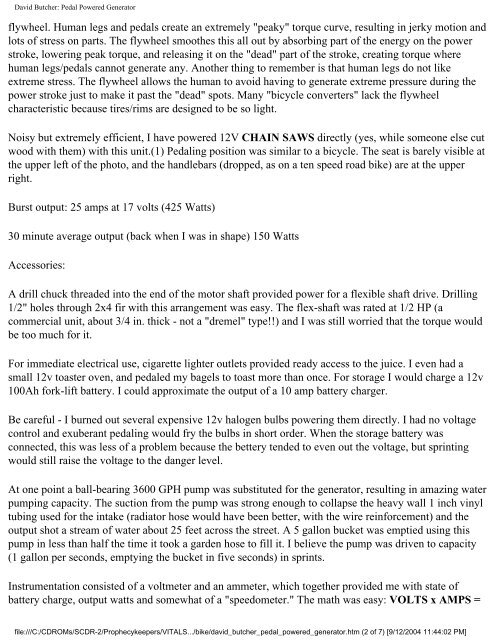David Butcher: Pedal Powered Generator - Pole Shift Survival ...
David Butcher: Pedal Powered Generator - Pole Shift Survival ...
David Butcher: Pedal Powered Generator - Pole Shift Survival ...
You also want an ePaper? Increase the reach of your titles
YUMPU automatically turns print PDFs into web optimized ePapers that Google loves.
<strong>David</strong> <strong>Butcher</strong>: <strong>Pedal</strong> <strong>Powered</strong> <strong>Generator</strong>flywheel. Human legs and pedals create an extremely "peaky" torque curve, resulting in jerky motion andlots of stress on parts. The flywheel smoothes this all out by absorbing part of the energy on the powerstroke, lowering peak torque, and releasing it on the "dead" part of the stroke, creating torque wherehuman legs/pedals cannot generate any. Another thing to remember is that human legs do not likeextreme stress. The flywheel allows the human to avoid having to generate extreme pressure during thepower stroke just to make it past the "dead" spots. Many "bicycle converters" lack the flywheelcharacteristic because tires/rims are designed to be so light.Noisy but extremely efficient, I have powered 12V CHAIN SAWS directly (yes, while someone else cutwood with them) with this unit.(1) <strong>Pedal</strong>ing position was similar to a bicycle. The seat is barely visible atthe upper left of the photo, and the handlebars (dropped, as on a ten speed road bike) are at the upperright.Burst output: 25 amps at 17 volts (425 Watts)30 minute average output (back when I was in shape) 150 WattsAccessories:A drill chuck threaded into the end of the motor shaft provided power for a flexible shaft drive. Drilling1/2" holes through 2x4 fir with this arrangement was easy. The flex-shaft was rated at 1/2 HP (acommercial unit, about 3/4 in. thick - not a "dremel" type!!) and I was still worried that the torque wouldbe too much for it.For immediate electrical use, cigarette lighter outlets provided ready access to the juice. I even had asmall 12v toaster oven, and pedaled my bagels to toast more than once. For storage I would charge a 12v100Ah fork-lift battery. I could approximate the output of a 10 amp battery charger.Be careful - I burned out several expensive 12v halogen bulbs powering them directly. I had no voltagecontrol and exuberant pedaling would fry the bulbs in short order. When the storage battery wasconnected, this was less of a problem because the bettery tended to even out the voltage, but sprintingwould still raise the voltage to the danger level.At one point a ball-bearing 3600 GPH pump was substituted for the generator, resulting in amazing waterpumping capacity. The suction from the pump was strong enough to collapse the heavy wall 1 inch vinyltubing used for the intake (radiator hose would have been better, with the wire reinforcement) and theoutput shot a stream of water about 25 feet across the street. A 5 gallon bucket was emptied using thispump in less than half the time it took a garden hose to fill it. I believe the pump was driven to capacity(1 gallon per seconds, emptying the bucket in five seconds) in sprints.Instrumentation consisted of a voltmeter and an ammeter, which together provided me with state ofbattery charge, output watts and somewhat of a "speedometer." The math was easy: VOLTS x AMPS =file:///C:/CDROMs/SCDR-2/Prophecykeepers/VITALS.../bike/david_butcher_pedal_powered_generator.htm (2 of 7) [9/12/2004 11:44:02 PM]
















